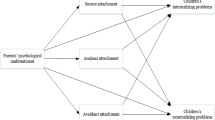Abstract
Sex differences in sequelae associated with levels of childhood physical mistreatment and verbal mistreatment were examined in a non-clinical sample of 272 university students. We predicted and found that both forms of mistreatment are related to attachment difficulties as well as various adverse psychological symptoms. We hypothesized, based on attachment theory, that the strength of a child’s attachment to one parent would moderate adverse emotional sequelae of mistreatment by the other parent. This prediction was only partially supported. Strength of the mother-daughter attachment moderated several of the adverse psychological symptoms in response to mistreatment by fathers, but mother-son attachment did not so moderate. Strength of the father-son attachment also did not moderate the symptoms associated with mistreatment perpetrated by mothers, nor did the father-daughter attachment. These results suggest that, among other relevant factors, sex differences should also be taken into account in treatment and prevention efforts.
Similar content being viewed by others
References
Ainsworth, M. D. S., Blehar, M. C., Waters, E., & Wall, S. (1978). Patterns of attachment: A psychological study of the Strange Situation. Hillsdale, NJ: Lawrence Erlbaum.
Aspelmeier, J. E., Elliott, A. N., & Smith, C. H. (2007). Childhood sexual abuse, attachment, and trauma symptoms in college females: the moderating role of attachment. Child abuse & neglect, 31, 549–566.
Bacon, H., & Richardson, S. (2001). Attachment theory and child abuse: an overview of the literature for practitioners. Child Abuse Review, 10, 377–397.
Bowlby, J. (1969). Attachment and loss (Vol. 1: Attachment). New York: Basic Books.
Bowlby, J. (1973). Attachment and loss (Vol. 2: Separation anxiety and anger). New York: Basic Books.
Bowlby, J. (1979). The making and breaking of affectional bonds. London: Tavistock Publications.
Bowlby, J. (1980). Attachment and loss (Vol. 3: Loss). New York: Basic Books.
Bowlby, J. (1988). A secure base: Parent-child attachments and healthy human development. New York: Basic Books.
Brennan, K. A., & Shaver, P. R. (1995). Dimensions of adult attachment, affect regulation, and romantic relationship functioning. Personality and Social Psychology Bulletin, 21, 267–283.
Briere, J., & Runtz, M. (1988). Multivariate correlates of childhood psychological and physical maltreatment among university women. Journal of elder abuse & neglect, 12, 331–341.
Briere, J., & Runtz, M. (1989). The trauma symptom checklist (TSC-33): early data on a new scale. Journal of interpersonal violence, 12, 151–163.
Cooper, M. L., Shaver, P. R., & Collins, N. L. (1998). Attachment styles, emotion regulation, and adjustment in adolescence. Journal of personality and social psychology, 74, 1380–1397.
Crittenden, P. M., Claussen, A. H., & Sugarman, D. B. (1994). Physical and psychological maltreatment in middle childhood and adolescence. Development and psychopathology, 6, 145–164.
Downs, W. R., & Harrison, L. (1998). Childhood maltreatment and the risk of substance problems in later life. Health & social care in the community, 6, 35–46.
Elliott, D. M., & Briere, J. (1992). Sexual abuse trauma among professional women: validating the Trauma Sympton Checklist-40 (TSC-40). Child Abuse Neglect, 16, 391–398.
Hazan, C., & Shaver, P. R. (1987). Romantic love conceptualized as an attachment process. Journal of personality and social psychology, 52, 511–524.
Howe, D. (2005). Child Abuse and Neglect: Attachment, Development and Intervention. New York: Palgrave Macmillan.
Main, M., & Solomon, J. (1986). Discovery of a new, insecure-disorganized/disoriented attachment pattern. In M. Yogman & T. B. Brazelton (Eds.), Affective Development in Infancy (pp. 95–124). Norwood, NJ: Ablex.
Malinosky-Rummell, R., & Hansen, D. J. (1993). Long-term consequences of childhood physical abuse. Psychological Bulletin, 114, 68–79.
Miller, G. A., & Lazowski, L. E. (1999). The Adult SASSI-3 manual. Spencer, IN: Evening World.
Reinert, D. F. (2005). Spirituality, self-representations, and attachment to parents: a longitudinal study of Roman Catholic college seminarians. Counsel. Values, 49, 226–238.
Rowatt, W. C., & Kirkpatrick, L. A. (2002). Two dimensions of attachment to God and their relation to affect, religiosity and personality constructs. Journal for the scientific study of religion, 41, 637–651.
Sachs-Ericsson, N., Verona, E., Jointer, T., & Preacher, K. J. (2006). Parental verbal abuse and the mediating role of self-criticism in adult internalizing disorders. Journal of affective disorders, 93, 71–78.
Stein, H., Jacobs, N. J., Ferguson, K. S., Allen, J. G., & Fonagy, P. (1998). What do adult attachment scales measure? Bulletin of the Menninger Clinic, 62, 33–82.
Styron, T., & Janoff-Bulman, R. (1997). Childhood attachment and abuse: long-term effects on adult attachment, depression, and conflict resolution. Child abuse & neglect, 21, 1015–1023.
Teicher, M. H., Samson, J. A., Polcari, A., & McGreenery, C. E. (2006). Sticks, stones, and hurtful words: relative effects of various forms of childhood maltreatment. American Journal of Psychiatry, 163, 993–1000.
Thompson, M. P., Kingree, J. B., & Desai, S. (2004). Gender differences in long-term health consequences of physical abuse of children: data from a nationally representative survey. American Journal of Public Health, 94, 599–604.
Yamamoto, M., Iwata, N., Tomoda, A., Tanaka, S., Fujimaki, K., & Kitamura, T. (1999). Child emotional and physical maltreatment and adolescent psychopathology: a community study in Japan. Journal of community psychology, 27, 377–391.
Warner, C. M., Warner, C. H., Breitbach, J., Rachal, J., Matuszak, T., & Grieger, T. A. (2007). Depression in entry-level military personnel. Military Medicine, 172, 795–799.
Zlotnick, C., Shea, M. T., Begin, A., Pearlstein, T., Simpson, E., & Costello, E. (1996). The validation of the Trauma Symptom Checklist-40 (TSC-40) in a sample of inpatients. Child abuse & neglect, 20, 503–510.
Author information
Authors and Affiliations
Corresponding author
Rights and permissions
About this article
Cite this article
Reinert, D.F., Edwards, C.E. Childhood Physical and Verbal Mistreatment, Psychological Symptoms, and Substance Use: Sex Differences and the Moderating Role of Attachment. J Fam Viol 24, 589–596 (2009). https://doi.org/10.1007/s10896-009-9257-0
Received:
Accepted:
Published:
Issue Date:
DOI: https://doi.org/10.1007/s10896-009-9257-0




